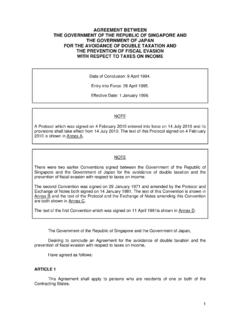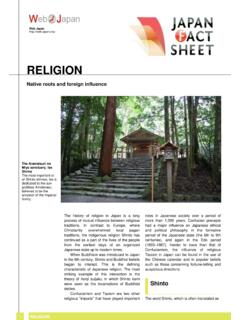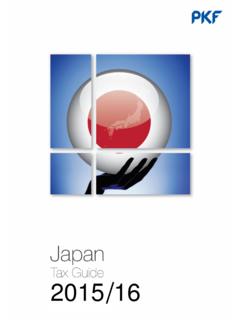Transcription of Japan - Earthquakes3 - OECD.org
1 OECD Studies in Risk ManagementJapanEARTHQUAKESOECD Studies in Risk Management JapanEARTHQUAKESL ooking back on the disasters of recent years alone (the Indian Ocean tsunami disaster, Hurricane Katrina, terrorist attacks in New York, Madrid and London, avian flu, the 2003 heat wave in Europe), one could be forgiven for thinking that we live in an increasingly dangerous world. A variety of forces are helping to shape the risks that affect us, from demographic evolutions to climate change, through the development of mega-cities and the rise of information technology. These changes are clearly a major challenge for risk management systems in OECD countries, which have occasionally proved unable to protect the life and welfare of citizens or the continuity of economic OECD Futures Project on Risk Management Policies was launched in 2003 in order to assist OECD countries in identifying the challenges of managing risks in the 21st century, and help them reflect on how best to address those challenges.
2 The focus is on the consistency of risk management policies and on their ability to deal with the challenges, present and future, created by systemic risks. The Project covers a range of risk management issues which were proposed by the participating countries and together form three thematic clusters: natural disasters, risks to critical infrastructures, and the protection of vulnerable population groups. In the first phase of the Project, the OECD Secretariat prepared a case study for each issue. The studies cover both recent international developments of interest and the national policy context, and come with a tool for self-assessment to be used later in the Project in order to review the national policies in question.
3 This work is now published as the OECD Studies in Risk Management. w w w. o e c d . o rgOECDOECD OECD (2006)Applications for permission to reproduce or translate all or part of this book should be made to OECD Publications, 2, rue Andr -Pascal, 75775 Paris Cedex 16, France credits: REUTERS / JEAN-PAUL PELISSIER, GETTY IMAGES. OECD STUDIES IN RISK MANAGEMENT ORGANISATION FOR ECONOMIC COOPERATION AND DEVELOPMENT Japan EARTHQUAKES 2 3 Foreword The OECD Futures Project on Risk Management Policies aims to assist OECD countries in identifying the challenges of managing risks in the 21st century, and contributing to their reflection on how best to address those challenges.
4 Its focus is placed on the consistency of risk management policies and on their ability to deal with the challenges, present and future, created by systemic risks. It is designed in two phases. In Phase 1, the countries participating in the project propose specific themes as case studies of their risk management policies. For each proposal, the OECD Secretariat prepares an overview of the issue covering both recent international developments of interest and the national policy context. In addition, the Secretariat elaborates a tool for self-assessment and review, consisting of one or several questionnaires following the methodological framework of the project.
5 This prepares the ground for Phase 2 in which an in-depth review of the risk management issues will be conducted by a team of experts for those countries that wish it. Self-assessments will be used as the basis of these reviews. At the end of phase 2, a cross-country report will bring together the lessons learned from the project, and identify opportunities for sharing best practices and improving risk management. In the framework of the OECD Futures Project on Risk Management Policies in Selected OECD Countries (RMP), the Japanese Cabinet Office and the Ministry of Land, Infrastructure and Transport (MLIT) have proposed a Phase 1 case study on Strategic Disaster Mitigation Policy for Large-Scale Earthquakes.
6 Japan is one of the most earthquake-prone countries in the world, and although the high level of economic and technological development has permitted the country to reduce human and economic consequences of earthquakes, the risk of a large-scale disaster cannot be eliminated. The most recent example of this is the Kobe (Great Hanshin-Awaji) earthquake in 1995 which caused the death of more than 6 000 persons. This study lays the ground for self-assessment and review of the earthquake disaster preparedness system of Japan . It has been prepared by Reza Lahidji and Marit Undseth from the OECD International Futures Program. The authors have benefited from the support of Hideki Hirai, at the Japanese Cabinet Office, Yoshiyuki Imamura, at the UNESCO, Masaru Kunitomo, at the River Bureau (MLIT), Kazuo Umeda, at Infrastructure Development Institute (IDI), as well as from the guidance of the Steering Group to the OECD Futures Project (see the list of Steering Group members in annex).
7 The study is issued under the responsibility of the Secretary General of the OECD. 4 5 Table of contents Introduction .. 7 I. Earthquake disaster management in 8 National context .. 8 The Japanese earthquake preparedness system .. 11 Areas of 12 II. Lessons learnt from past disasters .. 15 Historic and recent examples of large-scale earthquake disasters in 15 Recent earthquakes in other OECD countries .. 19 Lessons learnt .. 21 III. Consequences for risk management policy .. 25 Consequences for risk assessment: the need to improve our understanding of earthquake 25 Consequences for mitigation measures .. 26 Consequences for recovery 31 Strategic Issues .. 34 Conclusion and proposal for the second phase of the Project.
8 36 Bibliography .. 37 Annex 1: Overview of Japan s earthquake risk management system .. 41 Annex 2: The related legal and regulatory framework .. 43 Annex 3: Self-assessment questionnaire .. 45 Annex 4: Members of the Steering 57 6 7 Introduction In the past decade, it has become increasingly evident that the destruction potential of a wide range of natural and man-made hazards was growing in many OECD countries. One of the major reasons behind this trend is the concentration of people and economic assets in hazard-prone areas. In such circumstances, technology can mitigate the impact of hazards, but only to a certain degree.
9 This was observed in Kobe during the 1995 Great Hanshin-Awaji earthquake, where several hundred thousand people were left temporarily homeless, and where the entire city infrastructure had broken down. It is impossible for a city government, or even a region, to manage such a situation on its own. The increasing threat of mega-risks therefore urges for the creation of partnerships between the public and private sector, and between local community groups and the national government in order to assess, prevent and respond to harmful events. Seismic risk management policies in Japan are constantly confronting the possibility of other disasters of the magnitude of Kobe, as indicated by damage projections for the next major Tonankai-Nankai and Tokai earthquakes in central Honshu.
10 The Kobe earthquake highlighted some inadequacies in the Japanese disaster preparedness system, notably in preparedness at the city government level, in communication between government agencies, and in the seismic resistance of the building stock. In the ten years following it, many measures have been taken to address these problems. The aim of this study is to establish the basis for an appraisal of the earthquake disaster preparedness system in Japan . To this end, the study reviews recent experiences of earthquakes which are significant now and which might be of particular relevance for the coming decades.
















